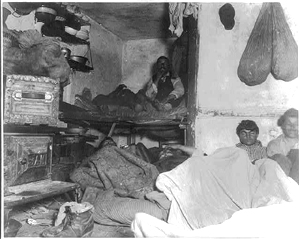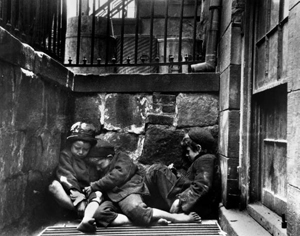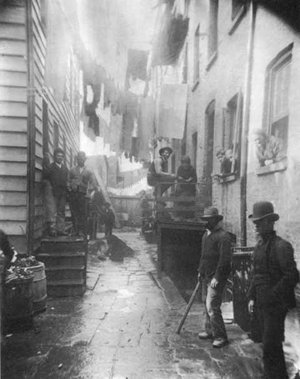|

Jacob
Riis
A
Danish immigrant, Jacob Riis was the pioneer in the use photography
as an instrument of reform. A crusading newspaper reporter who
took his camera into urban slums.
Riis
gained lasting recognition as a result of a book entitled How
the Other Half Lives. In the past, he wrote, “the half that
was on top cared little for the struggles, and less for the fate
of those who were underneath.” But he wanted to rectify
that omission.
Reading
Riis’s book today can be a disturbing experience. His book
is filled with condescending and insulting generalizations. Italian
immigrantss were “content to live in a pig-sty.” Chinese
immigrants were “in no sense a desirable element of the
population. For Eastern European Jews, he wrote, “Money
is their God. Life itself is of little value compared with even
the leanest bank account.” About African Americans, he wrote,
“Poverty, abuse and injustice alike the Negro accepts with
imperturbable cheerfulness.”
Take
a look at the following Riis photographs and read selections
from Jacob Riis' book, How the Other Half Lives, 1889.
 |
In a room not thirteen feet either
way slept twelve men and women, two or three in bunks set
in a sort of alcove, the rest on the floor. A kerosene lamp
burned dimly in the fearful atmosphere, probably to guide
other and later arrivals to their beds, for it was only just
past midnight.
A baby’s fretful wail came from an adjoining
hall-room, where, in the semi-darkness, three recumbent
figures could be made out. The apartment was one of three
in two
adjoining buildings we had found, within half an hour,
similarly crowded. Most of the men were lodgers, who slept
there for
five cents a spot. |
| Unauthorized immigration lodgings in a Bayard St. N.Y.C.
tenement, ca. 1890 |
| The twenty-five cent
lodging-house keeps up the pretence of a bedroom, though
the head-high
partition enclosing a
space just large enough to hold a cot and a chair and allow
the man room to pull off his clothes is the shallowest of
all pretenses. The fifteen-cent bed stands boldly forth without
screen in a room full of bunks with sheets as yellow and
blankets as foul. At the ten-cent level the locker for the
sleeper's clothes disappears. There is no longer need of
it. The tramp limit is reached, and there is nothing to
lock up save, on general principles, the lodger. Usually
the ten- and seven cent lodgings are different grades of
the same abomination. Some sort of an apology for a bed,
with mattress and blanket, represents the aristocratic purchase
of the tramp who, by a lucky stroke of beggary, has exchanged
the chance of an empty box or ash-barrel for shelter on the
quality floor of one of these "hotels." |
|
 |
I have not forgotten the deputation of
ragamuffins from a Mulberry Street alley that knocked at
my office door one morning on a mysterious expedition for
flowers, not for themselves, but for "a lady," and
having obtained what they wanted, trooped off to bestow
them, a ragged and dirty little band, with a solemnity
that was quite unusual.
It was not until an old man called the next day to thank
me for the flowers that I found out they had decked the
bier of a pauper, in the dark rear room where she lay waiting
in her pine-board coffin for the city's hearse.
Yet, as
I knew, that dismal alley with its bare brick walls,
between which no sun ever rose or set, was the world of
those children.
It filled their young lives. Probably not one of them
had ever been out of the sight of it. |
| Three children huddle for warmth in window well on NY's
Lower East Side |
|
 |
The years have brought to the
old houses unhonored age, a querulous second childhood that
is out of tune with
the time, their tenants, the neighbors, and cries out against
them and against you in fretful protest in every step on
their rotten floors or squeaky stairs.
Good cause have they
for their fretting. This one, with its shabby front and
poorly patched roof, what glowing firesides, what happy
children
may it once have owned? Heavy feet, too often with unsteady
step, for the pot-house is next door--where is it not
next door in these slums?--have worn away the brown-stone
steps
since; the broken columns at the door have rotted away
at the base.
Of the handsome cornice barely a trace is left.
Dirt and desolation reign in the wide hallway, and danger
lurks on the stairs. Rough pine boards fence off the
roomy fire-places--where coal is bought by the pail at
the rate
of twelve dollars a ton these have no place. The arched
gateway leads no longer to a shady bower on the banks of
the rushing
stream, inviting to day-dreams with its gentle repose,
but to a dark and nameless alley, shut in by high brick
walls,
cheerless as the lives of those they shelter. |
| Bandit’s
Roost, c. 1888 |
| The wolf knocks loudly at the gate in the troubled
dreams that come to this alley, echoes of the day's cares.
A horde of dirty children play about the dripping hydrant,
the only thing in the alley that thinks enough of its chance
to make the most of it: it is the best it can do. These are
the children of the tenements, the growing generation of
the slums; this their home. From the great highway overhead,
along which throbs the life-tide of two great cities, one
might drop a pebble into half a dozen such alleys. |
|
| |
|
| Home
of an Italian Ragpicker, 1888 |
|
|
